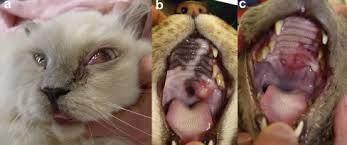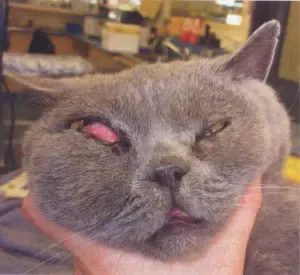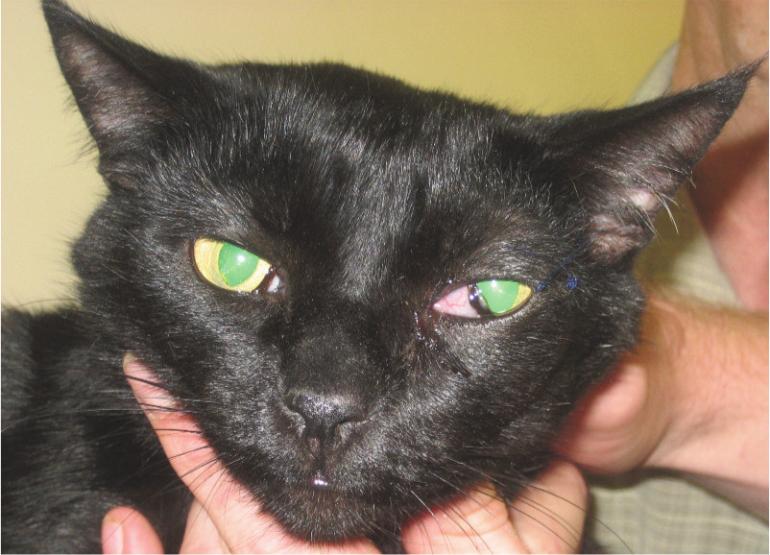Aspergillosis, Understanding the Fungal Disease, Symptoms, Diagnosis, and Treatment

Aspergillosis is a fungal disease caused by Aspergillus species, commonly found in the environment. While it primarily affects the respiratory system, it can also impact other organs in cats. Understanding the signs, diagnosis, and treatment options for aspergillosis is crucial for cat owners and veterinarians alike. This article explores the key aspects of this fungal disease, providing valuable insights for cat caregivers.
Aspergillosis (fungal disease)
Although it can strike cats at any age, fungal illness is most frequently observed in young to middle-aged cats (6.5 years old). The spores of the fungus are commonly present in the soil and are inhaled through the nose and lungs. The spores can be cleared from the respiratory tract by most cats, but in some, this is not possible, and the spores can grow into fungal plaques in the lungs, upper respiratory tract, or other parts of the body.
Cats can suffer from a variety of fungal diseases.One type of infection is called sinonasal aspergillosis (SNA), which only affects the upper respiratory tract. Another type is called sino-orbital aspergillosis (SOA), which is more severe and affects the area around the eyes.Some cats may get disseminated illness (also known as disseminated-invasive aspergillosis, or DIA) as a result of the fungus spores spreading throughout their body.
 How do cats get fungal infections?
How do cats get fungal infections?
The most common fungal species causing infection in cats are Aspergillus fellis, Aspergillus fumigatus and Aspergillus niger. This type of fungus is found worldwide in the environment and is usually associated with decaying vegetation, compost, mouldy hay etc.
Given that the majority of cats must come into contact with the fungus in their surroundings, it is unclear why some cats get sick. The majority of cats with the SNA or SOA are healthy, with one-third of documented cases being brachycephalic purebred cats like Persian and Himalayan cats.On rare occasions, illness may be observed in conjunction with foreign bodies or nasal malignancies.
Immunosuppression in cats with DIA is frequently linked to concomitant diseases, different viral infections (such as FeLV, FIV, FIP, and panleucopenia virus), or the use of immunosuppressive medications.

How would I know if my cat had fungal infection?
Sneezing and a watery to cream nasal discharge are the most prevalent clinical symptoms seen in cats with upper respiratory tract forms (SNA, SOA). In certain instances, nosebleeds and increased respiratory sounds may be noticed.The SOA form of the disease is characterized by swelling of the tissues next to the nose and eye, protrusion of the globe of the eye, and disease extension surrounding the eye. If the eye or brain are involved, blindness or convulsions may also be seen or reported.
Additionally, a variety of ambiguous and non-specific clinical symptoms may be present in cats with widespread illness.This can include symptoms like blood in the urine, vomiting, diarrhea, changes in appetite, breathing difficulties or coughing, depressive symptoms or abnormal mentation.
Symptoms
-
Nasal Discharge: Cats with nasal aspergillosis often exhibit persistent nasal discharge, which may be bloody or contain mucus.
-
Sneezing and Coughing: Chronic sneezing and coughing are common symptoms, indicating respiratory distress.
-
Difficulty Breathing: Cats may show signs of labored breathing, open-mouth breathing, or wheezing.
-
Loss of Appetite: Fungal infections can cause discomfort, leading to a reduced appetite and weight loss.
-
Facial Swelling: Swelling around the face and eyes can occur, especially if the sinuses are affected.
-
Lethargy: Cats with aspergillosis may appear lethargic and less active than usual.

How would my vet know what is wrong with my cat?
Based on your pet's symptoms, your veterinarian may be able to diagnose whatever ails them. To confirm the diagnosis and rule out any other potential reasons, more testing will be necessary. Blood and urine tests, head X-rays (or an MRI or CT scan), and potentially inserting an endoscope (a camera examination) into your cat's nose or lungs to obtain samples in order to look for and attempt to grow the fungus are probable among these procedures. A general anesthetic will be needed for these procedures.
There is a blood test available, but it's crucial to keep in mind that it's not always accurate and that some cats may test negative even though they are infected and some cats may test positive.For cats with DIA, this test is not particularly sensitive.
Diagnosis
Diagnosing aspergillosis in cats involves a combination of clinical examination, imaging studies, and laboratory tests:
-
Physical Examination: The veterinarian assesses the cat's symptoms and overall health.
-
Imaging: X-rays and CT scans can reveal abnormalities in the nasal passages and lungs, aiding in diagnosis.
-
Rhinoscopy: A rhinoscopy, using a thin tube with a camera, allows the vet to visualize the nasal passages and collect samples for biopsy.
-
Culture and Biopsy: Samples from nasal discharge or affected tissues can be cultured to identify the specific Aspergillus species and confirm the diagnosis.
Is there any treatment?
The treatment for fungal infection in cats is not straightforward and depends upon the form of disease diagnosed (SNA versus SOA versus DIA).
Treatment plans for cats with SNA focus on debridement, or the removal of as much of the infection as possible under anesthesia, followed by the application of liquid or cream antifungal medications directly to the infection site.Oral tablets might also be recommended, based on the specific Aspergillus species that has been diagnosed and the severity of the illness.To treat an infection, several topical treatments might be required, which would call for several anesthetics. Depending on how the patient presents and heals, hospitalization after the procedure can be required for a short while or for a longer time.
Oral antifungal drugs, either by itself or in conjunction with intravenous or subcutaneous injections of antifungal agents, are more frequently used in the treatment of cats diagnosed with SOA or DIA.Although these drugs are normally well tolerated, adverse effects can occur during therapy. As a result, depending on the prescription pill combination, routine clinical assessments and blood tests to evaluate liver function are frequently advised.
Depending on the indicators observed and the particular cat's tolerance to operations, extra supportive care, such as hydration therapy, nutritional support, pain medication, or seizure control, may be necessary for all forms of disease.
Treatment
Treatment for aspergillosis in cats typically involves a combination of antifungal medications, supportive care, and environmental management:
-
Antifungal Medications: Veterinarians prescribe antifungal drugs such as itraconazole or voriconazole to combat the fungal infection. Treatment can be prolonged, lasting several months, and requires regular monitoring.
-
Supportive Care: Cats may require supportive care, including intravenous fluids, nutritional support, and medications to manage symptoms like nasal congestion.
-
Environmental Management: Minimizing exposure to dust and mold is crucial. Keeping the cat's living area clean, ensuring good ventilation, and reducing the presence of moldy substances can prevent re-infection.
-
Regular Follow-up: Regular veterinary check-ups are essential to monitor the cat's progress, adjust medications, and assess overall health.
Will my cat get better?
The highest chance of recovery is for cats with sickness restricted to the nose (SNA), albeit this is still rare and the prognosis is still uncertain.
One of the best measures of how well a treatment is working is the resolution of clinical symptoms. After topical treatment, nasal discharge may get worse right away, but it usually gets better in a few weeks.About two weeks after therapy, it might be required to reexamine the nose using a combination of endoscopy and imaging (CT or MRI) to ensure that the fungus has been successfully cured. A second treatment is probably going to be suggested if the discharge doesn't go away or if there's any reason to suspect that the infection is still there after reevaluation.
Treatment options may be more limited and the prognosis is considered very poor where the fungus illness has expanded around the eye (SOA), into the brain, or in a disseminated form (DIA).
Is my cat likely to pass the disease to anyone in the household?
Since the fungus spores that cause Aspergillus infections are ubiquitous in the environment, both humans and dogs are typically exposed to them.Crucially, nasal aspergillosis is not thought to be communicable, and the majority of humans and animals do not contract the infection.
The surroundings will be less contaminated if you practice basic hygiene, such as wiping up nasal discharge and washing your hands after handling your pet. When dealing with an infected animal, it's advisable to take extra measures and speak with your doctor if any family members have weakened immune systems as a result of illness, certain medications, advanced age, or other conditions.Since the fungus spores that cause Aspergillus infections are ubiquitous in the environment, both humans and dogs are typically exposed to them.Crucially, nasal aspergillosis is not thought to be communicable, and the majority of humans and animals do not contract the infection.
How can I stop my cat getting a fungal infection?
There's really no way to keep your cat from coming into contact with the spores because they're found everywhere in the environment. It's crucial to keep in mind that most cats exposed to environmental aspergillosis never experience any issues. If your pet exhibits any of the following symptoms: sneezing, nosebleeds, swelling around the eyes or nose, or a persistent nose discharge, see your v
Conclusion
Aspergillosis in cats is a serious condition that requires prompt diagnosis and comprehensive treatment. With timely intervention, appropriate medications, and supportive care, affected cats can recover and lead fulfilling lives. Cat owners should remain vigilant for any signs of respiratory distress or nasal discharge and seek veterinary attention if such symptoms occur. Early detection and proper management are key to improving the cat's prognosis and ensuring their well-being.
eterinarian right once. Early diagnosis and treatment success may be enhanced.


